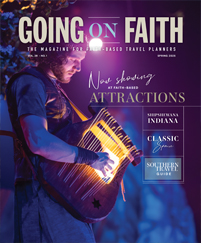Lafayette Parish in South Louisiana’s activity-filled Cajun country is proof that America is not so much a melting pot as it is a stew pot… or more appropriately a gumbo kettle. Stews and gumbos are not purees of their ingredients. They come together to create a new treat, while simultaneously preserving the identity of many of their components.
That’s oh so true down here in the swamps, rice fields and bayous around Lafayette. Lafayette Parish marked its 250th birthday in 2023. Lafayette itself — with a population of 121,000 and the amenities and services that group tours require — is the hub of Acadiana, a multi-parish region dotted with small towns and myriad attractions.
The region retains reminders of an exile in the 1700s that created Cajun culture and the influences of other groups, Spanish and Africans among them. It is a region renowned for its food, hospitality and joie de vivre. You seldom see anyone wearing a frown.
“Evangeline,” Henry Wadsworth Longfellow’s epic poem, immortalized the trauma when the British pushed Colonists of French heritage in Acadiana (what now is Atlantic Canada) into exile between 1755 and 1764. The refugees called it the Great Upheaval or the Great Expulsion, and many made it to south Louisiana, where the “Acadian” label eventually morphed into today’s word “Cajun.”
The Acadians were hardscrabble farmers trying to survive in a land that was far from ideal and unlike their Northern homes. They learned to build pirogues to travel on the slow-moving rivers (bayous), how to cultivate the arable land and how to live on nature’s bounty (crawfish, waterfowl, fish and oysters) — all while retaining a spirit of celebration.
That’s why Lafayette and Acadiana are blessed with excellent (but not fancy or pretentious) restaurants; a deep sense of history; Cajun and Zydeco music made distinctive with accordions, fiddles and triangles; and a spirit that can get almost anyone onto the dance floor.
Regardless of when you bring a group to Lafayette, you’ll find delicious food, interesting characters, irresistible music and good times.
‘Bring Your Stretchy Pants’ for a Food Tour
It’s almost impossible to make a restaurant mistake in Lafayette, but you can guarantee multiple successes by linking up with Marie Ducote, owner of Cajun Food Tours. She was a history teacher, but she left the classroom, bought a bus and began showcasing Acadiana’s downhome food scene. A tour with Ducote means sampling all kinds of Cajun treats at several stops, including the ultimate Cajun snack food, boudin (a mildly spicy rice and meat sausage whose makers guard their recipes closely). Ducote offers this advice: “Don’t eat before you come, and wear your stretchy pants.”
Step Back In Time at Vermilionville
If you can’t attend one of Lafayette’s numerous festivals (the Festival International de Louisiane in April and the Festivals Acadiens et Creoles in October are two of the biggest), Vermilionville is available all year. Vermilionville recreates an Acadian village from 1765-1890, featuring 19 restored and reproduced buildings. Real people bring it to life. Meet woodcarvers, weavers, spinners, accordion players, fiddle players and more, and sample authentic recipes at La Cuisine de Maman (Mama’s Kitchen), a restaurant where excellent gumbo competes for attention with chicken and sausage jambalaya, crawfish etouffee, shrimp etouffee and other temptations.
bayouvermiliondistrict.org/vermilionville
Get Close (But Not Too Close) to an Alligator
Although alligators are in the on-campus swamp at the University of Louisiana in Lafayette, a more memorable way to meet a gator is on a tour into the Atchafalaya Basin Swamp about 25 miles east. McGee’s Swamp Tours in Henderson has taken groups into the swamp for decades. A McGee boat ride is enlightening instead of ominous, thrilling instead of scary. This is America’s largest river swamp (it’s bigger than the Everglades) and is home to 65 reptile and amphibian species, more than 250 bird species (including nesting bald eagles), black bears, beavers, otters, raccoons and more. McGee’s offers traditional excursion boats and roaring airboats.
Remember a Poetry Lesson, Then Go Dancing
Louisiana’s first state park, Longfellow-Evangeline State Historic Site in St. Martinville, is a testament to the power of poetry and the emotional tale of separated lovers. The first Acadians to reach Louisiana established farms here along bayous Teche and Tortue. A reproduction farmstead is part of the park. Nearby is the Evangeline Oak, a massive live oak visitors associate with the fictional poem. A few miles up the road in Breaux Bridge are modern-day celebrations of the region’s culture — a Zydeco breakfast on Saturday or a Cajun band Thursday, Friday and Saturday nights at Buck and Johnny’s.
Spice Up Your Life with Tabasco
Peppers are one reason some Cajun and Creole food has a zing, and for a lot of people that zing comes from Tabasco brand sauce. Groups can see how the famous pepper sauce is made, shop, and enjoy a meal at Tabasco’s facility on Avery Island, about 30 miles from Lafayette. The story began with the bland diet of the Reconstruction South. Edmund McIlhenny wanted to spice things up. As an avid gardener, he acquired pepper seeds from Mexico and Central America and went into business in 1868. His business still is family-owned, and it has added eight variations of his original recipe — mild to wild.
tabasco.com/visit-avery-island
Visit America’s Oldest Rice Mill
Rice is essential for Louisiana food, which makes the Conrad Rice Mill in New Iberia even more interesting. The small operation is America’s oldest rice mill. P.A. Conrad founded the company in 1912 to grow and mill his own rice. The business grew, and Conrad began buying rice from other farmers. Today’s owners, Mike and Sandy Davis, offer low-key tours of the mill. But more importantly for groups, they operate a company store offering wild pecan rice, original brown rice, a long grain and wild rice mix, a paella rice mix and a curry rice mix. Spices include Creole seasoning, Greek seasoning and Gulf Coast seasoning blended especially for shrimp, crab, crawfish and chicken.










